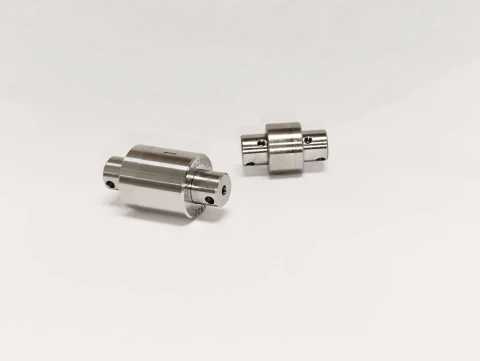Ascentta Polarization Dependent Free Space Circulator (532nm 635nm 780nm 850nm)
Description
The Polarization-Dependent 3-Port Circulator Core (TGG Type) by Ascentta Inc. is engineered for precise optical signal routing in demanding photonics applications. Designed to operate across key wavelengths—532 nm to 1064 nm—this compact circulator core utilizes the Faraday effect in TGG (terbium gallium garnet) material to provide superior isolation and directionality for linearly polarized light.
With an impressive minimum isolation of up to 22 dB and typical insertion loss as low as 0.3 dB, it guarantees high-performance operation while minimizing signal degradation. The circulator supports transmission directions 1→2 and 2→3, with excellent extinction ratios and directivity up to 30 dB, ensuring minimal crosstalk and high signal fidelity.
Available in a cylindrical package with varying apertures and dimensions to meet specific design requirements, this circulator is ideal for integration into OEM systems. It is particularly well-suited for laser systems, biomedical instrumentation, and optical sensing setups requiring precise polarization control.
For custom specifications, aperture sizes, or wavelength configurations, contact Ascentta directly.
Ascentta Polarization Dependent Free Space Circulator (532nm 635nm 780nm 850nm)
Specifications |
|
|---|---|
| Type Of The Device: | Circulator |
| Operating Wavelength: | 532 nm |
| Max Power: | 5 W |
| Min Isolation: | 21 dB |
| Insertion Loss (23℃, All SOP*) (1→2, Or 2→3) Max: | 0.6 dB |
| Extinction Ratio Min.: | 28 dB |
| Directivity (1→3, Or 3→1) Min.: | 30 dB |
| Clear Aperture: | 1.8 mm |
| Operation Temperature: | +10 to +50 °C |
| Storage Temperature: | 0 to +60 °C |
| Package Dimensions (Cylinder): | 10x50 mm |
Features
- Wavelength Versatility: Supports 532 nm to 1064 nm operations
- Low Insertion Loss: Typical values down to 0.3 dB for optimal performance
- High Isolation: Minimum 20–22 dB, with typical values up to 27 dB
- Excellent Extinction Ratio: ≥28 dB for precise polarization discrimination
- Superior Directivity: Minimum 30 dB for high signal integrity
- Customizable Design: Multiple aperture sizes, power handling, and dimensions available
Applications
- Laser Systems: Enables non-reciprocal signal routing in high-precision laser setups
- Optical Instrumentation: Ideal for systems requiring polarization-sensitive components
- Biomedical Imaging: Enhances accuracy and clarity in diagnostic devices
- Fiber Optic Sensing: Maintains signal directionality and polarization in sensing environments
- Quantum Optics and Research: Supports experimental setups with strict polarization control
For pricing, technical or any other questions please contact the supplier
- No registration required
- No markups, no fees
- Direct contact with supplier
-
Ships from:
United States
-
Sold by:
-
On FindLight:
since 2020
Frequently Asked Questions
The operating wavelengths for the circulator core are 532nm, 635nm, 650nm, 780nm, 850nm, 980nm, 1030nm, and 1064nm. Also customized.
The Transmitting Direction is 1→2, 2→3.
The typical and minimum Isolation values at 23℃ (room temperature) for each wavelength are as follows: - 532nm: 23dB (Typ.), 20dB (Min.) - 635nm: 23dB (Typ.), 20dB (Min.) - 650nm: 23dB (Typ.), 20dB (Min.) - 780nm: 25dB (Typ.), 21dB (Min.) - 850nm: 25dB (Typ.), 21dB (Min.) - 980nm: 27dB (Typ.), 22dB (Min.) - 1030nm: 27dB (Typ.), 22dB (Min.) - 1064nm: 27dB (Typ.), 22dB (Min.)
The typical and maximum Insertion Loss values at 23℃ for each wavelength are as follows: - 532nm: 0.4dB (Typ.), 0.6dB (Max.) - 635nm: 0.4dB (Typ.), 0.6dB (Max.) - 650nm: 0.4dB (Typ.), 0.6dB (Max.) - 780nm: 0.3dB (Typ.), 0.5dB (Max.) - 850nm: 0.3dB (Typ.), 0.5dB (Max.) - 980nm: 0.3dB (Typ.), 0.5dB (Max.) - 1030nm: 0.3dB (Typ.), 0.5dB (Max.) - 1064nm: 0.3dB (Typ.), 0.5dB (Max.)
The minimum Extinction Ratio for each wavelength is 28 dB. The Extinction Ratio is the ratio of the power of the orthogonal polarization states of light in a fiber.
The minimum Directivity for each wavelength is 30 dB. The Directivity is the measure of the intensity (power per unit surface) radiated by an antenna in the direction of its strongest emission.
The Package Dimensions (Cylinder) in millimeters for each wavelength are as follows: - 532nm: Ф16xL27 - 635nm: Ф16xL33 - 650nm: Ф16xL33 - 780nm: Ф19xL39 - 850nm: Ф19xL39 - 980nm: Ф19xL53 - 1030nm: Ф19xL53 - 1064nm: Ф19xL53
The operating temperature range is from 10 to 50 degrees Celsius, and the storage temperature range is from 0 to 60 degrees Celsius.
This information isn't directly provided in your input. The 'Ordering Information' section indicates that several custom configurations are possible, including varying port types, wavelengths, apertures, maximum power, and diameter and length of the component. Customers are encouraged to contact Ascentta with their specific needs.
SOP indicates the orientation of the plane of polarization which can vary across different points in an optical system. Here it is mentioned as "All SOP", meaning the listed specifications apply for all states of polarization.



